(E)-Nerolidol is a volatile signal that induces defenses against insects and pathogens in tea plants
- PMID: 32257238
- PMCID: PMC7109047
- DOI: 10.1038/s41438-020-0275-7
(E)-Nerolidol is a volatile signal that induces defenses against insects and pathogens in tea plants
Abstract
Plants release large amounts of volatile organic compounds (VOCs) in response to attackers. Several VOCs can serve as volatile signals to elicit defense responses in undamaged tissues and neighboring plants, but many questions about the ecological functions of VOCs remain unanswered. Tea plants are impacted by two harmful invaders, the piercing herbivore Empoasca (Matsumurasca) onukii Matsuda and the pathogen Colletotrichum fructicola. To determine the VOC signals in tea, we confirmed CsOPR3 as a marker gene and set up a rapid screening method based on a 1.51 kb CsOPR3 promoter fused with a β-glucuronidase (GUS) reporter construct (OPR3p::GUS) in Arabidopsis. Using this screening system, a terpenoid volatile (E)-nerolidol was identified as a potent signal that elicits plant defenses. The early responses triggered by (E)-nerolidol included the activation of a mitogen-activated protein kinase and WRKY, an H2O2 burst, and the induction of jasmonic acid and abscisic acid signaling. The induced plants accumulated high levels of defense-related chemicals, which possessed broad-spectrum anti-herbivore or anti-pathogen properties, and ultimately triggered resistance against Empoasca onukii and Colletotrichum fructicola in tea. We propose that these findings can supply an environmentally friendly management strategy for controlling an insect pest and a disease of tea plants.
Keywords: Plant biotechnology; Plant immunity.
© The Author(s) 2020.
Conflict of interest statement
Conflict of interestThe authors declare that they have no conflict of interest.
Figures
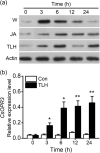
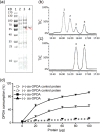
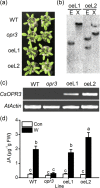
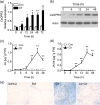

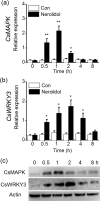
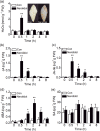
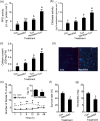

Similar articles
-
A Disease Resistance Elicitor Laminarin Enhances Tea Defense against a Piercing Herbivore Empoasca (Matsumurasca) onukii Matsuda.Sci Rep. 2019 Jan 28;9(1):814. doi: 10.1038/s41598-018-37424-7. Sci Rep. 2019. PMID: 30692583 Free PMC article.
-
Primary screening and application of repellent plant volatiles to control tea leafhopper, Empoasca onukii Matsuda.Pest Manag Sci. 2020 Apr;76(4):1304-1312. doi: 10.1002/ps.5641. Epub 2019 Nov 29. Pest Manag Sci. 2020. PMID: 31595641
-
Design of an Attractant for Empoasca onukii (Hemiptera: Cicadellidae) Based on the Volatile Components of Fresh Tea Leaves.J Econ Entomol. 2018 Apr 2;111(2):629-636. doi: 10.1093/jee/tox370. J Econ Entomol. 2018. PMID: 29361007
-
Elicitation of biomolecules as host defense arsenals during insect attacks on tea plants (Camellia sinensis (L.) Kuntze).Appl Microbiol Biotechnol. 2021 Oct;105(19):7187-7199. doi: 10.1007/s00253-021-11560-z. Epub 2021 Sep 13. Appl Microbiol Biotechnol. 2021. PMID: 34515843 Review.
-
The role of insect intestinal microbes in controlling of Empoasca onukii Matsuda (Hemiptera: Cicadellidae) pest infestations in the production of tea garden: a review.Arch Microbiol. 2023 Jun 23;205(7):267. doi: 10.1007/s00203-023-03609-6. Arch Microbiol. 2023. PMID: 37351731 Review.
Cited by
-
Enhanced volatile emissions and anti-herbivore functions mediated by the synergism between jasmonic acid and salicylic acid pathways in tea plants.Hortic Res. 2022 Jul 22;9:uhac144. doi: 10.1093/hr/uhac144. eCollection 2022. Hortic Res. 2022. PMID: 36101895 Free PMC article.
-
Botanic Garden as a Factory of Molecules: Myrtus communis L. subsp. communis as a Case Study.Plants (Basel). 2022 Mar 11;11(6):754. doi: 10.3390/plants11060754. Plants (Basel). 2022. PMID: 35336637 Free PMC article.
-
Volatile Signals From Guava Plants Prime Defense Signaling and Increase Jasmonate-Dependent Herbivore Resistance in Neighboring Citrus Plants.Front Plant Sci. 2022 Mar 10;13:833562. doi: 10.3389/fpls.2022.833562. eCollection 2022. Front Plant Sci. 2022. PMID: 35371180 Free PMC article.
-
Genome-Wide Identification and Expression Analysis of TPS Gene Family in Liriodendron chinense.Genes (Basel). 2023 Mar 22;14(3):770. doi: 10.3390/genes14030770. Genes (Basel). 2023. PMID: 36981040 Free PMC article.
-
Effect of the biosynthesis of the volatile compound phenylacetaldehyde on chloroplast modifications in tea (Camellia sinensis) plants.Hortic Res. 2023 Jan 11;10(3):uhad003. doi: 10.1093/hr/uhad003. eCollection 2023 Mar. Hortic Res. 2023. PMID: 37786771 Free PMC article.

